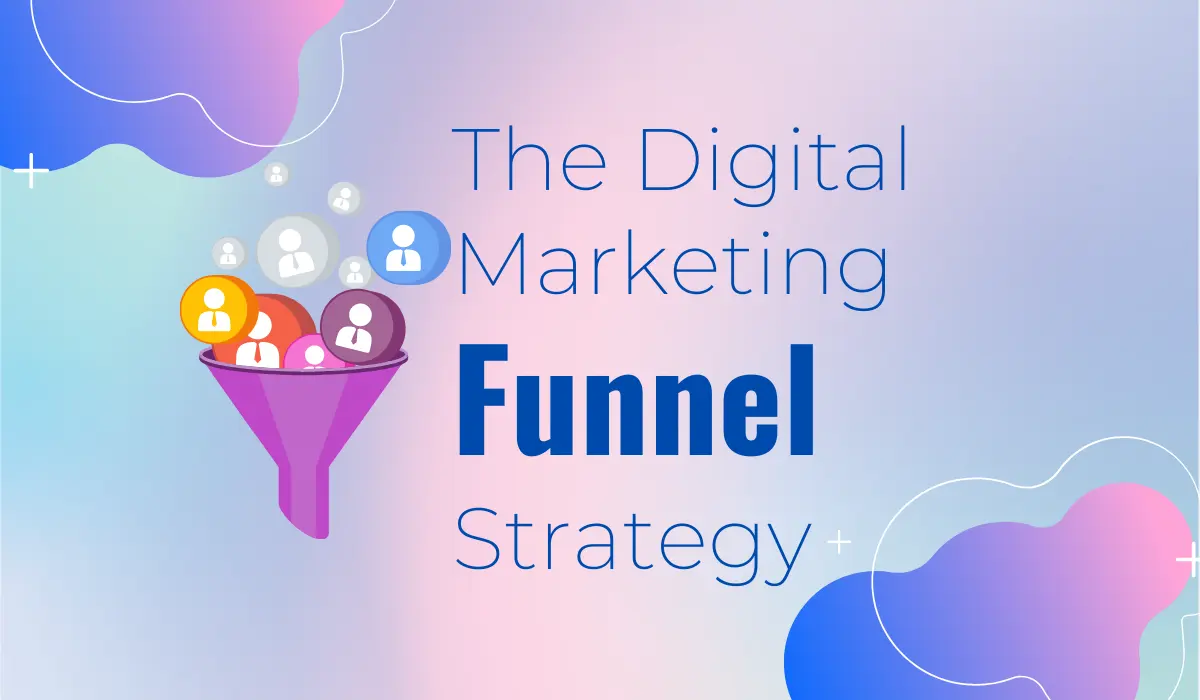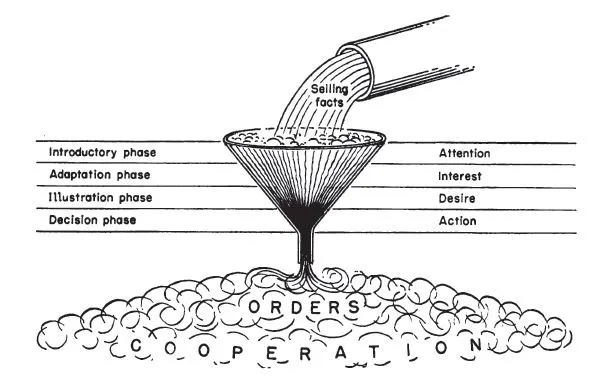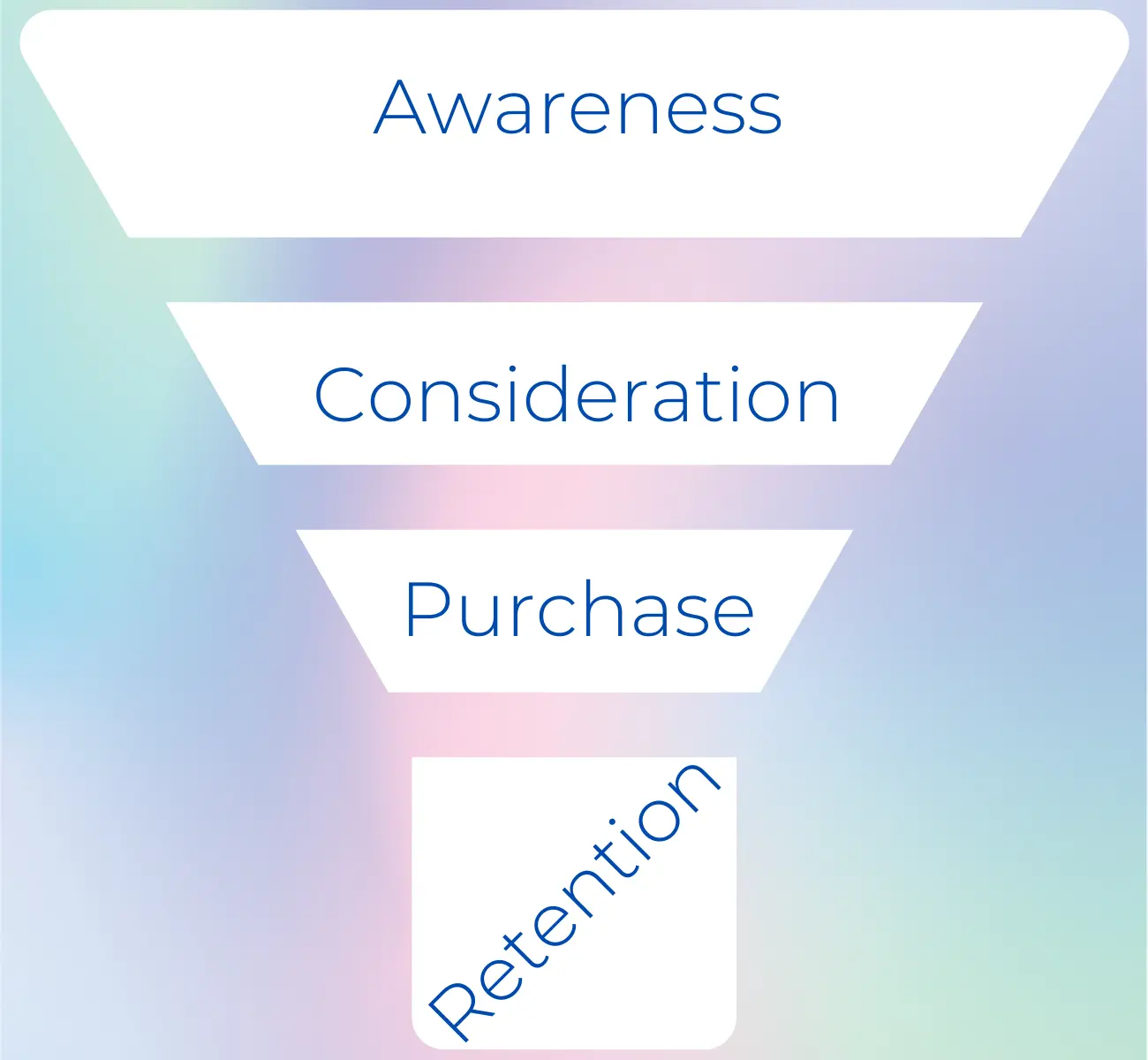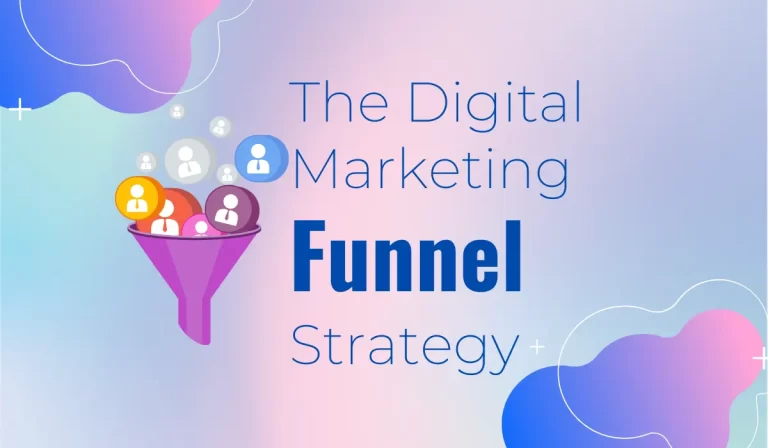Table Of Contents

Part 1: Overview of The Funnel Strategy
What is a Digital Marketing Funnel Strategy and How Does It Work?

David Wallace
October 21, 2022
What Is A Digital Marketing Funnel Strategy?
A physical plastic, metal, glass, or silicone funnel is an object with a wide top and a narrow bottom. Its main function is to pour anything pourable into another container, and to alleviate otherwise messy situations where the pourable substance could land in places it’s not meant to be. Funnels help us accomplish one goal, transferring something from one place to another, without any detours. Likewise, digital marketing funnels perform a similar task.
Instead of pouring a substance into a container, a “Digital Marketing Funnel Strategy” (“Digital Marketing Funnel: What's Changed? (And How to Adapt in 2021)”) helps to pour customers into a business. Simply defined, these funnels create a pathway for your target audience to go from not being a customer to becoming one.
Instead of pouring a substance into a container, a “Digital Marketing Funnel Strategy” (“Digital Marketing Funnel: What's Changed? (And How to Adapt in 2021)”) helps to pour customers into a business. Simply defined, these funnels create a pathway for your target audience to go from not being a customer to becoming one.
Where Did The Marketing Funnel Come From?
The idea of a sales funnel for marketing was established in 1898 by a man named E. St. Elmo Lewis (Ritson). It was essentially known as the first “theory” of marketing. The overall concept has evolved into one of the core aspects of any marketing strategy today; digital marketing funnels for customer captivation and retention.
Early Sales Funnel Illustrations
An early graphic to depict this type of funnel was found from 1904, depicted by Frank Hutchinson Dukesmith, editor of the Salesmanship magazine:

Though it doesn’t actually look like a funnel, the idea is similar. The diagram shows that every sale is “offset” by Attention, Interest, Desire and Conviction.
The second depiction of a sales funnel was published by Arthur F. Peterson, in his book, Pharmaceutical Selling, Detailing, and Sales Training about 50 years later:

The graphic above is possibly the first funnel strategy showing the closest resemblance to the digital strategies presented in modern marketing. The drawing also includes a brief overview of ‘the customer’s journey’ (“What is a customer journey? A definition”) in sectioned phases throughout the funnel.
The Customer's Journey
Most people don’t think about the journey they take before committing to a purchase or beginning an ongoing relationship with a business. Marketers do. Customers don’t immediately buy (“Customer Journey Definition”) something after finding it. Likewise, they don’t always find exactly what they need after wanting it. So, a properly working digital marketing funnel strategy will help them along their path to conversion or purchase. To better understand the digital funnel process, let’s put ourselves in the general scope of a consumer's journey.
Search
When someone has a need for a certain product or service, they search for it. If a company has what their target audience is looking for, they need to make sure their products or services show up in search (Dean). Which has to do with good SEO, paid ads, search terms, and brand expansion and all that it encompases. (link to pages on the website)
The online world makes it easy for people to buy online or find things digitally. With all the businesses that might do similar work, it can sometimes be hard for viewers to choose between different companies. Which is why most people don’t usually buy products or services right away. They look around for the best offer.
If you’re a business owner, you’ll want your viewers to have an easy time choosing you over your competition. The company that offers the best option will be chosen. Whether that choice is leveraged in price, quality, correct messaging, shipping times, aesthetics, constant communication, or something similar.
The online world makes it easy for people to buy online or find things digitally. With all the businesses that might do similar work, it can sometimes be hard for viewers to choose between different companies. Which is why most people don’t usually buy products or services right away. They look around for the best offer.
If you’re a business owner, you’ll want your viewers to have an easy time choosing you over your competition. The company that offers the best option will be chosen. Whether that choice is leveraged in price, quality, correct messaging, shipping times, aesthetics, constant communication, or something similar.
Discovery
There could be various channels of discovery (Sriram) for your target audience. They could find you through an online search for a product or service, through social media channels, non-web related marketing or even by word of mouth. When online, clicking on a website will often prompt a viewer with subscription asks, questionnaires, sale promotions, form fills and so on. These are just an example of the ways “discovery” can then lead people to a purchase along the customer journey.
More often than not, a prospective customer will search for similar companies after discovering yours. Looking for others who offer the same service or product but also offer a better deal is usually the reason. Once in a while someone will automatically buy from the first company they find, but assuming this for everyone would be a mistake. Assuring customers that your brand is the one on top is crucial.
Sometimes finding the best deal is all people need. For this reason, promotions are a big help in the digital marketing funnel, but more important is keeping the viewer interested in your brand. Which is where Customer Relationship Management (CRM) (Hanna) comes in.
A “better deal” isn’t always the way to go though. If you truly have a quality product that is worth a higher price, people will often stretch their budget for something that will give them more benefits in the long run. If a higher value product doesn’t cut it, having five star Google reviews (“5 Powerful Advantages of Google Reviews”) is important to outshine competitors as well.
More often than not, a prospective customer will search for similar companies after discovering yours. Looking for others who offer the same service or product but also offer a better deal is usually the reason. Once in a while someone will automatically buy from the first company they find, but assuming this for everyone would be a mistake. Assuring customers that your brand is the one on top is crucial.
Sometimes finding the best deal is all people need. For this reason, promotions are a big help in the digital marketing funnel, but more important is keeping the viewer interested in your brand. Which is where Customer Relationship Management (CRM) (Hanna) comes in.
A “better deal” isn’t always the way to go though. If you truly have a quality product that is worth a higher price, people will often stretch their budget for something that will give them more benefits in the long run. If a higher value product doesn’t cut it, having five star Google reviews (“5 Powerful Advantages of Google Reviews”) is important to outshine competitors as well.

Action
When it comes to customer relationship management, you’ll want to stay connected with your website viewers. For example, if a prospective customer agrees to subscribe to an email list, they should receive an automated email from your company. The majority of companies have something called marketing automation, which includes email blasting and other CRM technology that you’ll read more about below.
After receiving the email, they’ll do one of three things:
1. Act on the promotion
2. Save the email/code for another time
3. Change their mind
These actions will determine their next step in your business’s digital funnel. No matter what their action is, it shouldn’t deter any efforts to keep a connection. Even if they don’t choose to purchase from you after the first email, constant and well thought out email automation has the power to retain customers and generate leads over time (“Email Marketing Automation | The Definitive Guide in 2022”).
Digital marketing funnels are a long term strategy. They follow a gradual plan to keep people intrigued even when they aren’t making an action. We’ve highlighted digital marketing funnel strategy steps in our following blog if you want a better understanding of what the specifics look like.
After receiving the email, they’ll do one of three things:
1. Act on the promotion
2. Save the email/code for another time
3. Change their mind
These actions will determine their next step in your business’s digital funnel. No matter what their action is, it shouldn’t deter any efforts to keep a connection. Even if they don’t choose to purchase from you after the first email, constant and well thought out email automation has the power to retain customers and generate leads over time (“Email Marketing Automation | The Definitive Guide in 2022”).
Digital marketing funnels are a long term strategy. They follow a gradual plan to keep people intrigued even when they aren’t making an action. We’ve highlighted digital marketing funnel strategy steps in our following blog if you want a better understanding of what the specifics look like.
Disinterest
There’s always the possibility that consumers will become disinterested in your product or service and discard your emails. However, disinterest isn’t a cause for concern. It will help marketing teams fix and update possible problems within the funnel strategy. Did the email convey proper messaging? Were there shopping cart issues? How can we make email direction easier? Was website navigation stressful?
Practical questions and solutions are good for brainstorming innovative ideas to keep user engagement thriving. When people don’t follow through with an email, it’s not detrimental to the funnel. It’s a way to come up with new ideas to help your funnel improve as a whole.
Practical questions and solutions are good for brainstorming innovative ideas to keep user engagement thriving. When people don’t follow through with an email, it’s not detrimental to the funnel. It’s a way to come up with new ideas to help your funnel improve as a whole.
Reinterest
Emails aren’t the only part of a sales funnel. Capturing emails is valuable for being able to remind people of promos, send them new ones, and attract them to products they didn’t know were available. However, other ways of intriguing a target audience include targeted ads, social media, and most importantly, an attractive and usable website.
Website Importance
How a customer feels on your website is another huge part of a marketing funnel. From great SEO and online presence, to user experience and design, there’s so much that goes into a well functioning website that compliments any digital marketing funnel. We’ve explained some of those aspects in our site speed blog.
The General Digital Marketing Funnel
As online viewers make their way down a digital funnel, they are greeted with different steps that gradually take them from prospect to purchaser. These steps, like the call to actions and emails listed in the previous paragraphs, are the driving force to creating loyal customers. There are a number of different funnel strategies that companies use, including the AIDA (Attention, Interest, Desire, Action) format. Another basic way to label a marketing funnel could also look like the following:
- Awareness; similar to “attention.”
- Consideration; similar to “interest/desire.”
- Purchase; similar to “action.”
- Retention; an important aspect for gaining returning customers.

When a business presents their marketing strategy steps correctly, the viewer is not only drawn closer to the bottom of the funnel through engagement, but also secured at the bottom of the funnel and looped back to the top of the funnel as a returning customer. The execution of strategic digital funnel “steps” are what keep the attention of viewers. Effective guidance will lead your audience to be interactive with products, information, promotions, emails and more.
The hope that a viewer makes their way down the funnel to end in purchase and retention (“What Is Customer Retention? Definition, Examples, & Tools”), depends on overall website performance and the funnel strategy you choose. Different companies alter their marketing strategies to best fit their audience and their type of business, but the idea of getting customers from one place to another through the funnel system remains the same.
The hope that a viewer makes their way down the funnel to end in purchase and retention (“What Is Customer Retention? Definition, Examples, & Tools”), depends on overall website performance and the funnel strategy you choose. Different companies alter their marketing strategies to best fit their audience and their type of business, but the idea of getting customers from one place to another through the funnel system remains the same.
Marketing Automation
A large part of getting a user to interact with each digital marketing funnel step is through “Marketing Automation.” Marketing automation (“HubSpot Marketing | What is Marketing Automation?”) is exactly what it reads, automated marketing! When a business uses software technology to automate recurring and tedious marketing tasks, they’re using digital automation for promotion. Essentially making their duties a lot more organized and easier to manage.
Personalized Marketing
Automated marketing includes sending out personalized emails, campaigning, posting on social media platforms, customer onboarding, retrieving and reminding buyers of their abandoned shopping carts, sending updates, advertising and so much more. A vital part of automated marketing is that each task is personalized per viewer. The amount of personalization varies but it could be something as simple as company emails addressing their customers by name.
This is a block of text. Double-click this text to edit it. Multi-channel marketing through automation software isn’t done blindly. These types of marketing techniques are what push recurring personalized emails, targeted ads and relevant social media posts to your specified audience. The tools used with this software are important because they gather information and stored user data to promote to the individuals who are already (or who are most likely) to be interested in your business assets.
Mobile Marketing Automation
Mobile marketing automation is a popular marketing trend for 2022 (Avilés). A large majority of people nowadays do online browsing via mobile devices, and take their mobile device with them wherever they go. Mobile marketing automation can include sending push notifications, and SMS to promote user engagement, along with gathering location and browsing data for branding purposes. Utilize mobile marketing for optimal user engagement.
Multi-Channel Automation
Simply speaking, automated marketing software allows businesses to operate on multiple channels at the same time. Being able to function on different online platforms to complete a variety of automated tasks helps workflow. Not to mention, it helps companies give a lot more attention to individual customers than they’d be able to give manually.
Automated Marketing Is For Digital Marketing Funnels
Automated marketing softwares for sales funnel strategies are simple, manageable and productive with effective CRMs (Slingerland). A digital marketing funnel will get online viewers poured into your business, while creating an environment that makes purchasers want to return for future needs. Through marketing automation and continued outreach to maintain customer relations and expectations.
Musimack Marketing can help you build an optimal digital marketing funnel strategy that keeps your customers excited for what you continually have to offer. We are dedicated to developing a navigable user space where businesses thrive and shine online. Start constructing your digital marketing funnel strategy today.
Musimack Marketing can help you build an optimal digital marketing funnel strategy that keeps your customers excited for what you continually have to offer. We are dedicated to developing a navigable user space where businesses thrive and shine online. Start constructing your digital marketing funnel strategy today.
Resources
Avilés, Marina. “Digital Marketing Automation Trends for 2022.” Cyberclick, 7 March 2022, https://www.cyberclick.net/numericalblogen/digital-marketing-automation-trends-for-2022. Accessed 24 May 2022.
Brooks, Aaron. “Marketing Funnel Strategies: 5 Steps to Increase Sales in 2022.” Venture Harbour, 14 April 2022, https://www.ventureharbour.com/5-strategies-to-build-a-marketing-funnel-that-converts/. Accessed 31 May 2022.
“Customer Journey Definition.” Ryte, https://en.ryte.com/wiki/Customer_Journey. Accessed 25 May 2022.
Dean, Brian, and step guide. “How to Rank Higher On Google In 2022.” Backlinko, 8 November 2021, https://backlinko.com/rank-high-on-google. Accessed 25 May 2022.
“Digital Marketing Funnel: What's Changed? (And How to Adapt in 2021).” WebFX, https://www.webfx.com/internet-marketing/digital-marketing-funnel.html. Accessed 27 April 2022.
“Email Marketing Automation | The Definitive Guide in 2022.” Fidelitas Development, https://fidelitasdevelopment.com/the-definitive-guide-to-email-marketing-automation/. Accessed 25 May 2022.
“5 Powerful Advantages of Google Reviews.” Podium, https://www.podium.com/article/advantages-of-google-reviews/. Accessed 19 October 2022.
“4ways that email automation can improve your customer retention strategy | tye.” tye GmbH, 13 April 2021, https://www.tye.io/en/blog/marketing-automation-customer-retention/. Accessed 24 May 2022.
Hanna, Terrell. “What is CRM (customer relationship management)?” TechTarget, https://www.techtarget.com/searchcustomerexperience/definition/CRM-customer-relationship-management. Accessed 19 October 2022.
“HubSpot Marketing | What is Marketing Automation?” HubSpot, https://www.hubspot.com/marketing-automation-information. Accessed 27 April 2022.
Joshi, Meenu. “What is a CRM Funnel and How it Can Improve Your Sales Process.” LeadSquared, https://www.leadsquared.com/crm-funnel/. Accessed 27 April 2022.
Ritson, Mark. “Mark Ritson: If you think the sales funnel is dead, you've mistaken tactics for strategy.” Marketing Week, https://www.marketingweek.com/mark-ritson-if-you-think-the-sales-funnel-is-dead-youve-mistaken-tactics-for-strategy/. Accessed 27 April 2022.
Slingerland, Cody. “CRM Marketing Automation: Best CRMs for Marketing.” Nutshell, https://www.nutshell.com/blog/best-crms-for-marketing/. Accessed 27 April 2022.
Sriram, Akhila. “Stages of the Customer Journey: From Discovery to Purchase to Advocacy.” OSG Analytics, 12 August 2021, https://osganalytics.com/blog/stages-of-the-customer-journey-from-discovery-to-purchase-to-advocacy/. Accessed 25 May 2022.
“What is a customer journey? A definition.” Bynder, https://www.bynder.com/en/glossary/customer-journey/. Accessed 19 October 2022.
“What is CRM?” Salesforce, https://www.salesforce.com/crm/what-is-crm/. Accessed 27 April 2022.
“What Is Customer Retention? Definition, Examples, & Tools.” Amplitude, 23 March 2022, https://amplitude.com/blog/customer-retention. Accessed 19 October 2022.
Brooks, Aaron. “Marketing Funnel Strategies: 5 Steps to Increase Sales in 2022.” Venture Harbour, 14 April 2022, https://www.ventureharbour.com/5-strategies-to-build-a-marketing-funnel-that-converts/. Accessed 31 May 2022.
“Customer Journey Definition.” Ryte, https://en.ryte.com/wiki/Customer_Journey. Accessed 25 May 2022.
Dean, Brian, and step guide. “How to Rank Higher On Google In 2022.” Backlinko, 8 November 2021, https://backlinko.com/rank-high-on-google. Accessed 25 May 2022.
“Digital Marketing Funnel: What's Changed? (And How to Adapt in 2021).” WebFX, https://www.webfx.com/internet-marketing/digital-marketing-funnel.html. Accessed 27 April 2022.
“Email Marketing Automation | The Definitive Guide in 2022.” Fidelitas Development, https://fidelitasdevelopment.com/the-definitive-guide-to-email-marketing-automation/. Accessed 25 May 2022.
“5 Powerful Advantages of Google Reviews.” Podium, https://www.podium.com/article/advantages-of-google-reviews/. Accessed 19 October 2022.
“4ways that email automation can improve your customer retention strategy | tye.” tye GmbH, 13 April 2021, https://www.tye.io/en/blog/marketing-automation-customer-retention/. Accessed 24 May 2022.
Hanna, Terrell. “What is CRM (customer relationship management)?” TechTarget, https://www.techtarget.com/searchcustomerexperience/definition/CRM-customer-relationship-management. Accessed 19 October 2022.
“HubSpot Marketing | What is Marketing Automation?” HubSpot, https://www.hubspot.com/marketing-automation-information. Accessed 27 April 2022.
Joshi, Meenu. “What is a CRM Funnel and How it Can Improve Your Sales Process.” LeadSquared, https://www.leadsquared.com/crm-funnel/. Accessed 27 April 2022.
Ritson, Mark. “Mark Ritson: If you think the sales funnel is dead, you've mistaken tactics for strategy.” Marketing Week, https://www.marketingweek.com/mark-ritson-if-you-think-the-sales-funnel-is-dead-youve-mistaken-tactics-for-strategy/. Accessed 27 April 2022.
Slingerland, Cody. “CRM Marketing Automation: Best CRMs for Marketing.” Nutshell, https://www.nutshell.com/blog/best-crms-for-marketing/. Accessed 27 April 2022.
Sriram, Akhila. “Stages of the Customer Journey: From Discovery to Purchase to Advocacy.” OSG Analytics, 12 August 2021, https://osganalytics.com/blog/stages-of-the-customer-journey-from-discovery-to-purchase-to-advocacy/. Accessed 25 May 2022.
“What is a customer journey? A definition.” Bynder, https://www.bynder.com/en/glossary/customer-journey/. Accessed 19 October 2022.
“What is CRM?” Salesforce, https://www.salesforce.com/crm/what-is-crm/. Accessed 27 April 2022.
“What Is Customer Retention? Definition, Examples, & Tools.” Amplitude, 23 March 2022, https://amplitude.com/blog/customer-retention. Accessed 19 October 2022.
About The Author
David to write something about himself for his author bio...
